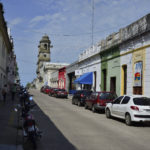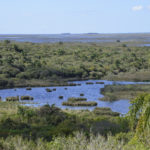For English version click on “BEITRAG LESEN/READ THE POST” and then scroll to bottom
Nachdem wir viel länger als geplant an der Küste Uruguays geblieben sind, geht es jetzt westlich ins Landesinnere. Wir sind im Gaucholand und die Landschaft ist nicht sehr abwechslungsreich und besteht jetzt hauptsächlich aus großen offenen Weideflächen, auf denen sich die Rinderherden verlaufen. Durch den Regen der letzten Tage, stehen die Rinder zum Teil bis zum Bauch im Wasser. Neben Eukalyptusbäumen, die wir hier überhaupt nicht erwartet hatten, gibt es viele Palmen. Einige davon sind nur in Uruguay heimisch. Für uns wirkt es schon ein bisschen skuril, wenn wir Kühe unter Palmen weiden sehen. Unseren ersten Übernachtungsstop machen wir in Nico Perez auf dem Camping Municipal. Wie wir im weitern Verlauf der Tour feststellen, hat fast jeder Ort einen Parque Municipal, in dem es Spielgeräte, Grillstellen und Picknickplätze gibt. Teilweise kann man in den Parks auch mit dem Wohnmobil oder Zelt übernachten und es gibt Toiletten und manchmal auch Duschen. Da wir noch in der Vorsaison sind, sind die meisten Parks aber noch nicht so richtig hergerichtet; sprich die Toiletten und Duschen lassen noch zu wünschen übrig. Für uns sind es aber immer gute und sichere Stellplätze. Bis zur nächsten Übernachtung fahren wir nur etwas mehr als 50 km, den bereits 7 km hinter dem Ortsausgang von Nico Perez beginnt eine der übelsten Schotter- und Schlaglochpisten, die wir bisher hatten. Für 47 km brauchen wir fast 2,5 Stunden auf der Ruta 14, einer der Hauptverbindungsstrassen in den Westen. Als wir in Sarandi del Yi ankommen, ist Ralph geschafft. Da es auch hier öffentliche Stellplätze in einem schönen Park gibt, beschließen wir, nicht mehr weiter zu fahren. Ralph bastelt noch ein bißchen am Auto (unsere Wasseranzeige spinnt) und bekommt prompt Besuch von einem jungen Pärchen, das uns Hilfe anbietet. Die Verständigung ist zwar nicht einfach, aber mit Google-Translate geht (fast) alles. Die nächste Etappe führt uns über die längste Baustelle, die wir je gefahren sind. Auf Rund 135 km reiht sich eine Baustelle an die andere. Die meiste Zeit besteht die Straße aus Schotter und festgefahrenem Sand. Sie läßt sich aber relativ gut fahren. In Trinidad finden wir einen Stellplatz im Parque Centenario. Der Park ist sehr gepflegt und die Toiletten sind sehr sauber. Wir könnten sogar warm Duschen. Dafür müssen wir die Parkaufsicht informieren und sie schließen die Duschräume dann auf. Wir laufen aber erstmal zur Touristinformation und treffen auf zwei junge Deutsche, die dort ein Freiwilligenjahr machen. Weiter geht es über die Ruta 3 aber wir machen noch einen Abstecher zu den Grutas del Palacio. Bei den Grutas handelt es sich nicht um Höhlen in die man herabsteigt, sondern um eine Felsabbruchkante mit säulenartigen Steinresten, in die man ein Stück reinlaufen kann. Die Besichtigung ist nur mit Führer möglich und sehr interessant. Im Café gönnen wir uns noch einen Snack und nutzen das gute WiFi. Danach fahren wir nicht mehr weit bis zum Parque Bartolomé Hidalgo. Der Platz liegt an einem künstlich angelegten Stausee (zur Stromerzeugung) und ist sehr gepflegt. Leider haben die Stellplätzen am See keinen Strom auf den Steckdosen. Wir beschließen, zwei Nächte zu bleiben und nutzen die Zeit um am Unimog Öl und Schmiernippel zu kontrollieren. Die letzten Tage hatten wir immer wieder abwechselnd 1-2 Tage Sonnenschein und dann Regen und so ist auch hier der 2. Tag wieder verregnet. Unsere letzte Etappe in Uruguay führt uns nach Paysún. Dort holen wir nochmal Geld, checken im Shopping Center unsere Emails und versuchen (erfolglos) an zwei verschiedenen Gasläden einen Adapter für die amerikanische Gasflasche zu bekommen. Gegen 15h fahren wir dann zur Grenze, wo uns jemand die Einfuhrerlaubnis für Albatros entwertet und dann sind wir schon aus Uruguay ausgereist.
FAZIT: Irgendwie hatten wir Uruguay so gar nicht auf unserem Radarschirm und waren angenehm überrascht. Es ist zwar eines der teuren Länder Südamerikas aber die endlosen Sandstrände und vielen Parks und Übernachtungsmöglichkeiten, haben uns sehr gut gefallen. Zwar liegt auch hier an vielen Stellen Müll rum, aber meistens war es deutlich sauberer, als wir es von Lateinamerika kannten und erwartet hatten. In Montevideo gibt es viele alte Gebäude, an denen man sieht, welche Bedeutung die Stadt und das Land mal hatten. Leider wurden viele ihrem Schicksal überlassen und gammeln so vor sich hin. Was wir im ganzen Land und durch alle Schichten und Generationen gesehen haben, ist der Genuss von Mate Tee. Zur Grundausstattung gehört eine Thermoskanne (in die Armbeuge geklemmt) und in der Hand der typische Becher mit dem ”Strohhalm”. Zur Ergänzung gibt es ganz unterschiedliche Tragebehälter – vom zusammengezimmerten Holzkasten mit Griff bis hin zur eleganten Ledertasche – und passende Dosen für Zucker und Mate. Auffällig war auch, dass Salz in Uruguay ziemlich “verteufelt” wird. In Restaurants werden Gerichte zum Teil ungesalzen gekocht und auf einigen Lebensmitteln (z. B. Brotsorten) wird extra darauf hingewiesen, dass kein Salz enthalten ist. Im krassen Gegensatz dazu steht jedoch die Vorliebe für Dulce de Leche, eine Karamelcreme, die in fast allen Süßspeisen verwendet oder wie Marmelade aufs Brot gegessen wird, und fritiertes Gebäck (teilweise dann noch mit Dulce de Leche gefüllt).
English Version (no translation of German text)
After spending much more time on the Uruguayan coast than we had planned, we are now heading West into the country. This is clearly gaucho country. The landscape is dominated by huge cattle fields. Since it rained the last couple of days, the cattle sometimes is more than knee deep in water. Besides the eukalyptus trees, which we didn’t expect to see here at all, there are a lot of palm trees. Some of them you will only find in Uruguay. For us it is a bit surreal to see cattle grazing below palm trees. Our first overnight stop is in Nico Perez on a municipal campground. We’ll find out, that most towns have a municipal park with a lot of equipment for kids, BBQ sites and picnic areas. Some of them have sites to camp with an RV or a tent as well and there are toilets and sometimes even showers. Since it still is pre-season, some of them are not fully up and running yet; e.g. toilets and showers are not the cleanest. However, for us they are always good and secure place for an overnight stay. The next leg of our trip is only a bit more than 31 miles since shortly after we leave the city limits of Nico Perez, Ruta 14, one of the main connections to the West, turns into one of the worst gravel roads covered with potholes. It takes us nearly 2.5 hrs to drive 29 miles. When we reach Sarandi del Yi Ralph is totally exhausted. Since they have nice municipal camp sites as well, we decide to not further move on. Ralph starts looking into an issue with the display of our water tanks and it doesn’t take long until a young couple approaches us and asks if they can provide some help. Communication is not easy but with google-translate we manage (nearly everything). The next part of the trip feels as if we are driving the longest road work we’ve ever experienced. On nearly 84 miles there is one road work after the other. Most of the time the road is only gravel but it is relatively good to drive. In Trinidad we find a place in “Parque Centenario”, which is very well groomed and has clean toilets. There is even the option to take a warm shower. We only need to inform the guard and they will open the shower block. We stroll through the city and meet two young Germans who are doing a volunteer job at the tourist information center. We continue on Ruta 3 but take a short deviation to the Grutas del Palacio. They are not caves in the traditional way but more a cliff where erosion has left only a few columns of stone. The tour can only be done with a guide and is very interesting. Once back we have a snack at the café and use their good WiFi. It’s only a few kilometers further down the road until we reach our next destination; Parque Bartolomé Hidalgo. The park is at a man-made lake (used for generating electricity) and again very well kept. Unfortunately, the outlets at the sites closer to the lake are not (yet?) connected to electricity. We spend two days and do a bit of service for our Unimog. The last couple of days we had a mix of 1-2 days of sunshine followed by rain and again the 2nd day here is rainy. Our last stop in Uruguay is in Paysún. We draw some money from the bank, check our eMails at the shopping mall and try (without success) at two different shops to get an adapter for our American gas bottle. Around 3pm we drive to the Argentinian border, where the TIP (temporary import permit) for Albatros is voided and then we have already left Uruguay.
Conclusion: Somehow Uruguay wasn’t on our radar screen and we where positively surprised. Although it is one of the most expensive countries in South America, we really liked the sheer endless beaches and the many parks and overnight sites. There is waste at some sites, but it was much cleaner than Latin American and than we expected. In Montevideo we saw a lot of old buildings proofing the importance of the city and the country in the past. Unfortunately, a lot of them are not looked after and just vanishing away. What we noted in the whole country and across all classes and ages is the love for Mate tea. The basic equipment consists of a thermos flask (carried in the crook of the arm) and the typical Mate cup with the specific “straw”. Additionally, you can buy a whole lot of extra equipment such as carrying tools (starting with self-made wooden boxes with handles up to elegant leather bags), and matching containers for sugar and Mate. Another striking thing is, that in Uruguay salt is pretty much sentenced. In restaurants often the meals are prepared without salt and they specifically highlight food without salt (e.g. various types of bread). In contrast to this is the love for Dulce de Leche, a caramel cream, that is used in nearly all deserts or eaten on bread like marmalade, and fried pastries (often filled with Dulce de Leche).



























Liebe Ute lieber Ralph,
endlich mal Zeit um in Ruhe und mit großem Interesse euren Reisebericht Uruguay zu verfolgen.
Habt weiter eine gute Reise, es ist immer wieder schön von euch zu hören..